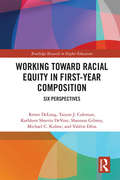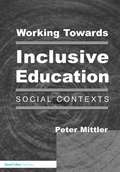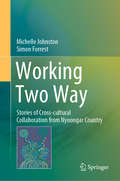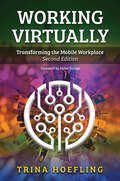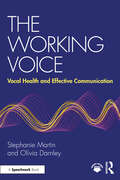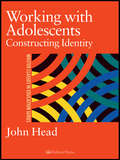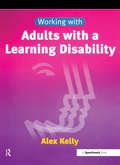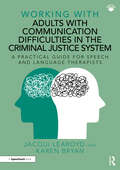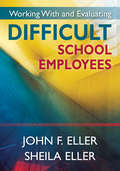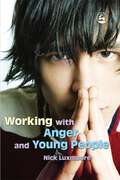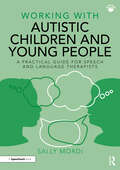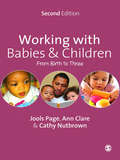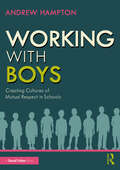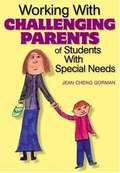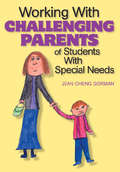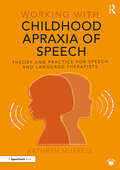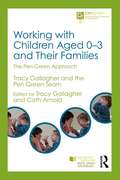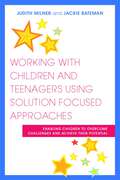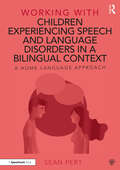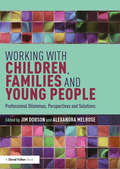- Table View
- List View
Working Toward Racial Equity in First-Year Composition: Six Perspectives (Routledge Research in Higher Education)
by Shannon Gibney Renee DeLong Taiyon Coleman Kathleen Sheerin DeVore Michael Kuhne Valerie DéusThis book presents the authors’ attempts to interrogate the ways that white institutional, pedagogical, and curricular heteronormativity affects equity in writing instruction at Two Year Colleges. Written from a wide range of subject and identity positions, this volume explores issues that arise among students inside historically white-dominant classrooms, among faculty as curriculum and hiring decisions are made, and among colleagues when they attempt to engage the wider institution in equity work. Aiming to significantly change how urban Community College writing instruction is delivered in this country, the book operates on the principle that equity is essential to successful writing pedagogy, curricular development, and student success.
Working Towards a Proficiency Scale of Business English Writing: A Mixed-Methods Approach
by Li Wang Jason FanThis book presents an empirical study to develop and validate a proficiency scale of business English writing in the Chinese tertiary context. Through a mixture of intuitive, quantitative and qualitative methods, the book demonstrates how a pool of descriptors are collectively formulated, statistically calibrated and meticulously validated for the establishment of a proficiency scale of business English writing. The writing scale differs in significant ways from the existing language scales, most of which were constructed in English as L1 or L2 contexts and applied to English for General Purposes (EGP) domains. This book also provides important insights into the construct of business English writing as well as the methods for English for Specific Purposes (ESP) proficiency scale development and validation. It is of particular interest to those who work in the area of ESP teaching and assessment.
Working Towards Inclusive Education: Social Contexts
by Peter MittlerThis book provides a clearly written, wide-ranging overview of current key issues and challenges arising from the implementation of more inclusive policies and provision in education in this country and internationally. The author sets policies for inclusive schools in the broader contexts of current policies which aim to reduce poverty and social exclusion, and the wider global background of the United Nations drive to promote 'Education for All'. The book draws a distinction between integration and inclusion and provides a critical analysis of the government's Program of Action and the revised National Curriculum and their implications for schools, pupils and families.
Working Two Way: Stories of Cross-cultural Collaboration from Nyoongar Country
by Michelle Johnston Simon ForrestThis book describes an action research approach to engaging respectfully with First Nations communities in a diverse range of contexts, disciplines and projects. It offers a valuable guide for professionals, students and teaching staff that recognises all participants as equal partners while acknowledging the diversity of First Peoples and culture, and prioritising local knowledge. While the book is adaptable to a diverse range of cultures and disciplines, it is specifically focused on cross-cultural collaborative case studies in Noongar Country, which is located in the southwest of Western Australia. The case studies demonstrate how action research can be applied not only in the traditional areas of education and social justice, but also in a diverse range of disciplines, communities and circumstances, including media, education, environmental management and health. The book’s aim is to highlight successful cross-cultural First Nations community projects and to discuss each one in terms of its action research philosophy and process. In this regard, the voices of the participants are prioritised, especially those of First Nations communities. While this book is specifically pitched at Australian readers, the action research approach described may be adapted and applied to many cross-cultural collaborative relationships, making it of interest and value to international students and researchers.
Working Virtually: Transforming the Mobile Workplace
by Trina HoeflingRemote working is the new reality, and transactional work – provided by freelancers, contract employees or consultants – has increased exponentially. It is forecast that as much as half the labor force will be working independently and virtually by 2020.Most organizations are still grappling with how to effectively manage their virtual staff and how to effectively support and motivate them – an increasingly urgent task as more Millennials join the workforce, bringing changed attitudes to work satisfaction. This book, the fruit of the author’s three decades of experience planning and implementing remote working environments, provides expert guidance for anyone planning a shift to remote working, managing teams of teleworkers, or themselves working in a virtual team.Working Virtually is for the executive leading changes in an enterprise that is preparing for virtual work or seeking to improve current performance. It offers tools to assess readiness, advice on creating appropriate reward policies, and strategies to adapt performance management processes to be more team-driven and technology leveraged. Working Virtually is written to and for the virtual leader who wants to establish high performing virtual teams. It provides an understanding of the roles and responsibilities of managing a virtual team, offering a wealth of advice on creating the conditions for collaboration, motivating team members, and identifying and defusing problems.Working Virtually is for the professional who works remotely from home, on the road, or in an office with remote colleagues. It is for anyone who wants to succeed in this new work environment by developing skills and networks to create a sustained and satisfying career path.With this new edition providing a 360° view of the roles and objectives of all stakeholders in the virtual workspace, this book uniquely provides readers with a rounded picture of the policies, processes, work habits, and commitments needed to achieve the shared goal of high performance remote teams.
The Working Voice: Vocal Health and Effective Communication
by Stephanie Martin Olivia DarnleyThe Working Voice is an accessible, go-to resource to help readers get to know, take care of, and develop their voice. An essential guide for anyone whose voice acts as an integral part of their professional role, this highly practical yet informative book provides the necessary insights to achieve real results, drawing on the experience of an expert speech and language therapist, and an accomplished actor and voice and communication coach.Each chapter offers a wealth of information on a key element of voice, including posture, tension release, breathing, resonance, volume, intonation and effective communication, alongside advice and exercises to maintain your vocal health and empower your communication in the workplace. The book includes self-assessment checklists, questionnaires and thought-provoking prompts to help you understand your voice better, identify the challenges you face as a professional voice user. It also contains exercises to enhance your vocal ability. Expert advice on what to embrace and what to avoid ensures a safe and structured path towards vocal health, quality and authentic presence.This crucial introduction to voice in the professional workplace will benefit anyone who speaks as part of their job, including education, law, media, health, entertainment and corporate professionals, whether communicating in person, online or to a large audience.
Working With Adolescents: Constructing identity
by Dr John Head John HeadThis work examines the way in which personality and identity of the pupil is shaped by his or her experiences in school. The text considers the way in which teachers in secondary schools are working, and to some extent living, with adolescent pupils for the majority of time in their weekday waking lives. The book examines: to what extent teachers provide both positive and negative role models for pupils to follow; the factors restricting the ability of teachers to teach effectively; and conversely, what factors work to their advantage.; The text provides an overview of the debates and research into areas of: teaching children about controversial subjects such as sex and drugs; gender differences; identities; peer groups; relations with adults; and beliefs and values.
Working with Adults with a Learning Disability (Working With Series)
by Alex KellyA comprehensive and practical resource for all speech and language therapists and students, this book covers all aspects of working with this client group. Written by the author of the hugely successful "Talkabout", each section gives the reader a theoretical background of the subject under discussion, practical suggestions and formats for assessment, a guide to intervention as well as a clear and worked-out example. In addition, the author addresses staff training, group therapy, accessing the criminal justice system and working with a multi-disciplinary team.
Working With Adults with Communication Difficulties in the Criminal Justice System: A Practical Guide for Speech and Language Therapists (Working With)
by Jacqui Learoyd Karen BryanThis book offers guidance for speech and language therapists and other professionals who are working in a criminal justice setting or who are interested to know more about this dynamic and rewarding client group. The criminal justice system (CJS) includes police custody, community services, secure hospitals and prisons. Although each setting has its differences, there are overarching areas associated with speech, language and communication needs (SLCN) within the population who find themselves coming into contact with the CJS. These needs are many and varied: from social deprivation and developmental language disorder, to head injury, substance misuse and ADHD. The variety is both stimulating and challenging, and this book provides the reader with a range of resources to use with such a complex client base. Key features include: ● academic evidence about SLCN in the CJS ● accessible visuals explaining the systems pathways ● resources to support assessment and intervention ● information to support individuals with a range of overlapping needs. Aimed primarily at speech and language therapists, the book also includes useful content for students, academics and professionals who wish to know more about SLCN within the CJS. As well as being full of useful infographics, this book includes a vast appendix of online material that can be downloaded and printed for use in practice.
Working with Adults with Eating, Drinking and Swallowing Needs: A Holistic Approach (Working With)
by Sophie MacKenzieThis practical guide encourages clinicians to treat eating, drinking and swallowing in a holistic way, keeping the client at the forefront of management by considering cultural, ethical and societal infl uences on the eating and drinking process. It draws on contemporary evidence to critically evaluate assessment and management strategies.Closely aligning to the 20 RCSLT newly qualified practitioner eating, drinking and swallowing competencies, this book will provide clinicians with the theory that underpins the statutory completion of these standards, and the guidance to put that theory into practice. This book: Is clear and easy to follow with information broken down into a digestible format. Includes regular questions to help the reader consolidate their knowledge. Highlights in each chapter the knowledge required to achieve the RCSLT competencies. Contains a wealth of case studies SLTs may encounter in different settings, followed by suggested approaches. Provides helpful resources that can be downloaded and printed for use in daily practice. Working with Adults with Eating, Drinking and Swallowing Needs provides an up-to-date, clinically relevant resource. With an emphasis on clinical decision-making, holistic practice and provision of practical materials, this is an essential text for both student and qualified SLT practitioners.
Working With and Evaluating Difficult School Employees
by John F. Eller Sheila A. EllerHelp marginal employees take positive steps to improve their performance and behavior! Managing difficult employees is one of the most challenging aspects of a school leader’s job. Written by experienced administrators, this resource provides specific strategies to identify, work with, and evaluate employees who have marginal, deficient, or negative behaviors. This book includes: Sample dialogues for conducting difficult conversations; Templates for putting concerns into writing and developing improvement plans; Information about legal issues and ways to protect yourself; Methods for working with teachers, secretaries and assistants, paraprofessionals, and custodial staff; Steps to take when termination becomes necessary.
Working with Anger and Young People
by Nick LuxmooreUnderstanding the roots of anger and encouraging appropriate and acceptable ways of expressing this are essential skills for anyone working with young people. Working with Anger and Young People warns against 'quick fix' solutions to dealing with anger, and draws on the author's experiences of youth counselling and training workshops to propose helpful interventions for addressing anger effectively and moving on from it. From attachment anxieties and feelings of powerlessness, to frustration at difficult family relations, Nick Luxmoore considers the common reasons for young people's anger during this difficult stage of their development. Through accounts of his work with a range of young people, he offers tried-and-tested exercises and talking points to help work through common counterproductive responses to anger such as antisocial behaviour and physical or verbal violence. Crucially, he also recognises the needs of those working with these young people with anger problems and provides advice on working safely, maintaining control and achieving job satisfaction. This sensitive, accessible book will be an informative and engaging resource for anyone working with young people with anger issues.
Working with Asperger Syndrome in the Classroom
by Gill D. AnsellHaving an array of effective strategies at your fingertips and understanding exactly why they work makes supporting children with Asperger Syndrome in the classroom a whole lot easier. This accessible, short and snappy guide to the basics will provide busy teachers and teaching assistants with everything they need to know to make their job easier, and to make a real difference to any student with AS in their care. The book begins by exploring how children with AS operate and the implications this has for mainstream school settings. It goes on to give practical advice for one-on-one working, DIY resources for visual learners, tools for effective assessment, and much more. Information on how personal wellbeing can be maintained in potentially stressful situations is also included, and the concise chapters are ideal for dipping into as and when inspiration is needed. This book will be an essential resource for any teacher or teaching assistant supporting children with Asperger Syndrome.
Working with Autistic Children and Young People: A Practical Guide for Speech and Language Therapists (Working With)
by Sally MordiThis book focuses on appreciating the different language and communication style of autistic youngsters and discusses how therapists can respond to and support this to get the best out of their practice. Each chapter begins with a summary of key points and areas to focus on, includes ‘what to do’ ideas and mini case-studies to illustrate points, as well as signposting further reading. The book draws on relevant theory and offers practical insights to allow the therapist to develop confidence, knowledge and skills. Topics covered include: identifying effective support, emotional regulation, working with technology, specific groups such as girls with autism. Linking theory and practice in an engaging and easy-to-follow format, The book provides practical ideas that are immediately helpful for busy professionals to guide clinical decision making and intervention. It is an invaluable addition to the tool kit of any speech and language therapist, as well as other professionals wanting an overview of how to work with autistic children and young people in our neurodiverse society.
Working with Babies and Children (Second Edition): From Birth to Three
by Cathy Nutbrown Jools Page Ann Clare'The first edition of this book set a milestone in writing about under threes. This second edition builds on that great achievement: its thinking about loving interactions in nurseries marks it out for its bravery and profound importance for a new generation of practice'-Peter Elfer, University of Roehampton 'The authors skilfully interlace theory and practice, foregrounding an ethic of respect and prompting critical reflection and dialogue' -Dr Sacha Powell, Reader in Early Childhood, Canterbury Christ Church University 'This clear, authoritative and scholarly book is informed by the authors' huge respect and affection for young children and those who work with them. A must-read'-Helen Moylett, Early Learning Consultancy This book is essential for all who work with children under three. Due to its combination of theory and practice, clear writing and pedagogical material. The second edition contains extensive updates on policy, new case studies, and activities from current settings. This revised edition emphasises: - child development and learning - attachment/key person relationships - planning the environment for babies - understanding every child - working with parents This book will be useful to those on initial training courses, such as Foundation degrees, NVQ, BA Education and Early Childhood Studies, and for managers and practitioners undertaking CPD. Jools Page teaches on the MA in Early Childhood Education at the University of Sheffield. Ann Clare is an Associate Tutor at the University of Sheffield. Cathy Nutbrown is Head of the School of Education at the University of Sheffield.
Working with Boys: Creating Cultures of Mutual Respect in Schools
by Andrew HamptonWhen peer-on-peer sexual abuse becomes commonplace in schools, society has a problem. The toxic attitudes and behaviour some boys display towards girls and women begin with the way those boys relate to each other, especially in school. This book offers an in-depth analysis of the problems facing boys and gives teachers the tools to help boys create relational cultures that are mutually respectful. Part One of the book looks at how boys relate to each other and how that affects the way they relate to girls and women. Part Two outlines a programme that can be delivered, lesson by lesson, to pupils aged 9 to 18. The programme covers specific lesson topics that can be adapted for different age groups, including: • Anger • Banter • Fear of humiliation • Boy hierarchies • Jostling and consent • Crying and emotional expression • Lifestyle choices Working with Boys is a whole-school, iterative programme of study that uses guided reflection to empower boys to self-regulate their attitudes and behaviour. This book is essential reading for school leaders and teachers who want to promote a school environment in which boys are consistently principled, honourable, noble, trustworthy, upright and dignified.
Working with Challenging Parents of Students With Special Needs
by Jean Cheng Gorman'This practical guide will help avert obstacles and clear the way for a healthy and productive working relationship that will benefit the individuals who are at the center of the enterprise - the children!' - Lawrence Balter, Professor, New York University Most teaching programs do not cover how to handle difficult parents, especially parents of special needs children. This book fills that gap, focusing both on dealing with specific problems and cultivating strong relationships with parents. In specific settings such as IEP meetings and transitional plan meetings, you will learn how to understand the parents' perspective while arming yourself with methods to address their concerns and move beyond conflict to true collaboration. The book's contents, grounded in research as well as real-life experiences, include chapters to help you: - create partnerships by examining such concepts as empathy, communication, and risk management; - deal with specific problems, such as parents who are angry, non-participatory, or plaintive; - work with groups with unique concerns, such as grandparents, foster parents, noncustodial parents, and homeless families; - cultivate and maintain good collaborative relationships with parents. The easy-to-use layout first presents research and discusses the reasons behind particular problems, followed by clear main strategies to solving the problems and actions to avoid. A summary and questions at the end of each chapter, as well as the included extensive forms, let you examine your specific professional situation.
Working With Challenging Parents of Students With Special Needs
by Jean Cheng GormanMove beyond conflict to true collaboration with difficult parents of children with special needs by understanding their perspectives and using appropriate methods to address their concerns!
Working with Child and Adolescent Mental Health: The Central Role of Language and Communication (Working With)
by Susan McCoolIn children, mental health challenges and communication differences typically combine in complex and inter-related ways. Remarkably, this crucial point is all too often forgotten, and communication is overlooked. Services are frequently fragmented, leading professionals to look at children through distinct lenses of either mental health or communication, meaning insights can be incomplete and important perspectives unshared. Working with Child and Adolescent Mental Health makes the compelling case that communication is central and should be a primary consideration whenever we think about children’s mental health. With a practical focus, and an easy- to-read format, it suggests how this can be achieved by identifying how practitioners and services can work more cohesively to understand and optimise children’s communication capacities. This book includes: • Practical advice, grounded in current research, and presented in an easy-to-read, digestible style • Guidance to help practitioners competently and compassionately identify and respond to the needs of children and young people with complex combined communication and mental health needs • Real-life case studies from a wide range of settings, unpicked to clearly illustrate topics discussed in the book and offer encouragement and inspiration to practitioners • Checklists and questionnaires to help practitioners in daily practice • Recommendations for, and links to, useful additional resources • Tools to support reflection and enhancement for individual practitioners and services Essential reading for speech and language therapists, psychologists, mental health practitioners, educators, social workers, and anyone else concerned with children’s wellbeing and resilience, this book highlights the transformational impact of placing communication at the heart of all efforts to support children and young people’s mental health.
Working with Childhood Apraxia of Speech: Theory and Practice for Speech and Language Therapists (Working With)
by Kathryn MurrellThis resource will lead the reader through the practicalities of assessment, diagnosis, and therapeutic intervention for children of all ages with features of childhood apraxia of speech. It provides the theory and underlying principles upon which to work with children who have this fascinating but challenging disorder in collaboration with families and schools. Chapters are clearly laid out, with hands on activities for intervention and helpful summaries. There is a focus on alternative and augmentative means of communication and multidisciplinary working, as well as a wealth of case studies and teaching notes for training other professionals. Fresh ways of working are addressed, such as the use of teletherapy and other techniques such as group therapy and the consultative approach are discussed. Key features include: A theoretical overview of current thinking about childhood apraxia of speech A structured assessment format with a chapter specifically focused on how to take a detailed speech sample Clear guidance on how to make a differential diagnosis How to spot early indicators of childhood apraxia of speech Advice sheets for parents and schools Downloadable record forms for case history taking and assessment. This book can be read cover to cover or dipped into for quick and easy therapy ideas and is presented in an easy-to-read format, with chapters broken down into bite-sized chunks. It is an essential handbook for all speech and language therapists and students, whatever their level of experience.
Working with Childhood Apraxia of Speech: Theory and Practice for Speech and Language Therapists (Working With)
by Kathryn MurrellThis resource will lead the reader through the practicalities of assessment, diagnosis, and therapeutic intervention for children of all ages with features of childhood apraxia of speech. It provides the theory and underlying principles upon which to work with children who have this fascinating but challenging disorder in collaboration with families and schools.Chapters are clearly laid out, with hands on activities for intervention and helpful summaries. There is a focus on alternative and augmentative means of communication and multidisciplinary working, as well as a wealth of case studies and teaching notes for training other professionals. Fresh ways of working are addressed, such as the use of teletherapy and other techniques such as group therapy and the consultative approach are discussed.Key features include: A theoretical overview of current thinking about childhood apraxia of speech A structured assessment format with a chapter specifically focused on how to take a detailed speech sample Clear guidance on how to make a differential diagnosis How to spot early indicators of childhood apraxia of speech Advice sheets for parents and schools Downloadable record forms for case history taking and assessment. This book can be read cover to cover or dipped into for quick and easy therapy ideas and is presented in an easy-to-read format, with chapters broken down into bite-sized chunks. It is an essential handbook for all speech and language therapists and students, whatever their level of experience.
Working with Children Aged 0-3 and Their Families: The Pen Green Approach (Pen Green Books for Early Years Educators)
by Tracy Gallagher Cath ArnoldThis inspiring book shows how Early Years staff can support the best possible practice for children under three and their families whilst making use of the limited funding available. Promoting the idea of infants as powerful learners, the authors focus on 0-3 years as the vital first phase of education and care, which can require a very specific pedagogical approach. They discuss the principles that underpin the practice of working with the youngest children, the critical nature of highly effective pedagogical practice and the important role of family workers in building relationships with parents and the extended family. Working with Children Aged 0–3 and Their Families explores the challenges and responsibilities of working with young children and communicates the ‘Pen Green approach’. Pen Green has become a focal point for Early Years professionals due to its outstanding Early Years provision. The innovative approach chronicled in this book will encourage practitioners to research their own practice and use the outcomes to create a radical, unique and yet highly effective provision for infants, toddlers and their families. The book will be of interest to Early Years professionals, foundation and undergraduate students, and early childhood educators.
Working with Children and Teenagers Using Solution Focused Approaches
by Jackie Bateman Judith MilnerSolution focused approaches offer proven ways of helping children overcome a whole range of difficulties, from academic problems to mental health issues, by helping them to identify their strengths and achievements. Based on solution focused practice principles, this book illustrates communication skills and playful techniques for working with all children and young people, regardless of any health, learning or development need. It demonstrates how the approach can capture children's views, wishes and worries, and can assist them in identifying their strengths and abilities. The approach encourages positive decision-making, and helps children to overcome challenges, achieve their goals and reach their full potential. The book is packed with case examples, practical strategies, and practice activities. This valuable text will be of great use to a range of practitioners working with children and young people, including social workers, youth workers, counsellors, teachers and nurses.
Working with Children Experiencing Speech and Language Disorders in a Bilingual Context: A Home Language Approach (Working With)
by Sean PertThe complexity of speech and language disorders can be daunting in a monolingual context. When working with a bilingual child assessment and intervention may appear to be even more complicated. In this book Sean Pert provides the reader with the tools needed to overcome this perception and develop skills in working in a language that they don’t share with the client. By adopting a home language first approach the book discusses how to: identify diversity from disorder introduce effective approaches in line with the best clinical practice work successfully alongside interpreters make assessments and plan interventions set goals for therapy. At the heart of the text is the therapist creating essential partnerships with parents and truly valuing the bilingualism, culture and identity of the child. This leads to better outcomes, not only in speech, language and communication, but also in self-esteem, mental health, social participation and educational and employment success. The book concludes with a handy toolkit of resources including quizzes, case studies and printable extras making it the perfect resource for both experienced and newly qualified practitioners with bilingual and multilingual children in their care.
Working with Children, Families and Young People: Professional Dilemmas, Perspectives and Solutions
by Jim DobsonBridging the gap between learning and the application of knowledge and skills in Early Years settings, this book addresses the nuanced complexities and challenges which students may face as they progress into professional practice. Built around the experiences of undergraduate students, solution-focussed chapters tackle contemporary issues such as safeguarding, new materialism, reflective practice, and working with refugee children, linking these to theoretical and philosophical models and drawing on undergraduate and practitioner insights. Providing contextualised examples, insight into key issues, and application of theory to practice, this book offers incisive solutions to support the undergraduate journey into a career, with chapters covering topics such as: Best practice as a practitioner creating a caring environment Reflecting on practice to cultivate professional development Working with and for marginalised children Reflective practice Working with Children, Families and Young People is perfect for undergraduate students on Early Years and Childhood Studies courses, as well as other courses pertaining to working with children and young families, social work, and young communities.
